How to make 2023’s biggest interiors trend work in your home
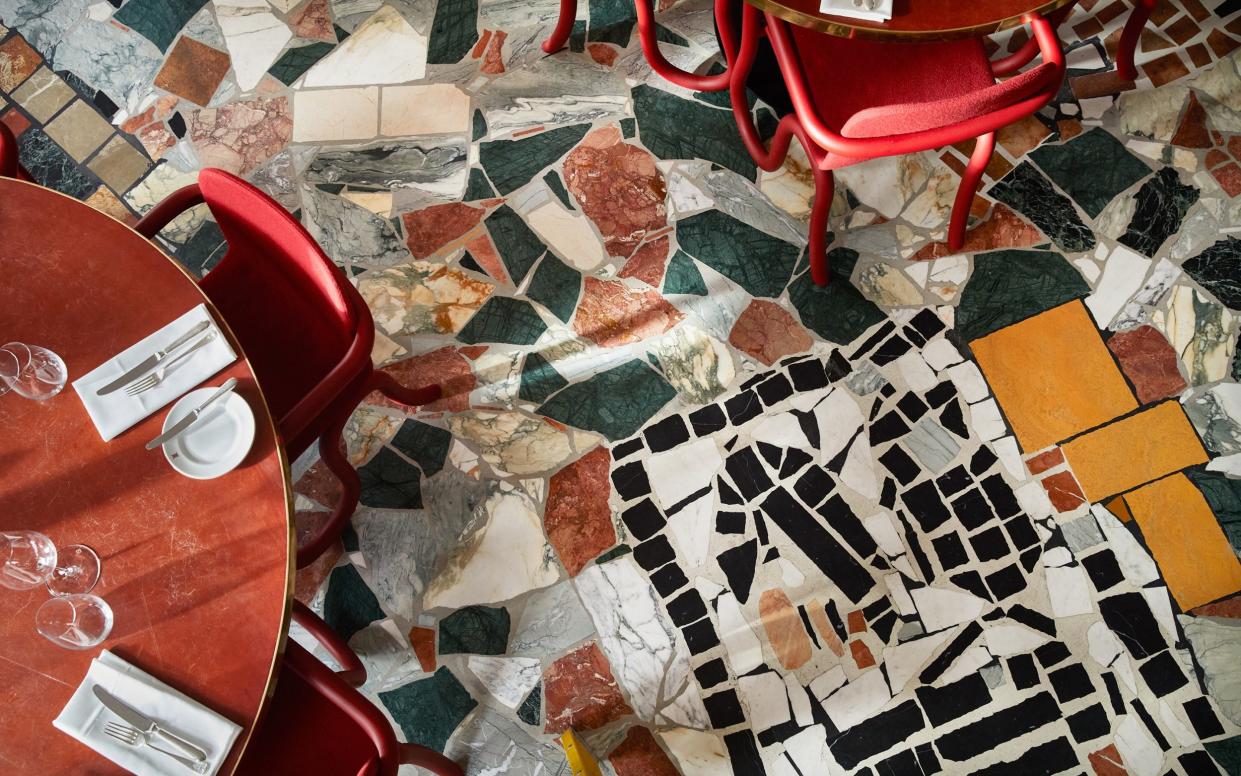
Even when storm clouds gather over its willowy spires, Milan’s Duomo seems to exude an ethereal glow. Believers might say this is because the cathedral is one of the world’s holiest sites, a 600-years-in-the-making statement of artistry, power, wealth and faith; others might put it down to the rare, pink-streaked Candoglia marble from which it is made.
Candoglia marble has been quarried for the mighty cathedral since 1387, when Gian Galeazzo Visconti, then Lord of Milan and later its first duke, declared that marble, rather than brick, should be used. Famed for its unique tint and slender veins flecked with grey and green, it is found exclusively at the entrance to the Ossola Valley. Extraction is difficult and costly. For many Italians, it’s the most precious marble of them all.
But there are other varieties of this beautiful rock; over in Venice the medieval builders carved their city in luminescent Carrara, red Rosso Verona and green Verde Alpi. Candoglia was reserved for the floor of the famous ‘marble church’, Santa Maria dei Miracoli.
As they worked, skilled Venetians noted that marble off-cuts could make strong surfaces themselves. Lacking the means of aristocrats, these craftsmen scooped up the leftovers and used them to make floors and terraces in their own homes (‘terrazzo’ is Italian for terrace). They would level their floors by hand or later with a galera – a long-handled, weighted grinding stone – before using goat’s milk to bring out the sheen.
Five hundred years on, terrazzo, or graniglia as it is known in Italy, has not lost touch with its humble origins. It appears all over Italy, on office buildings and schools, hospitals and airports. ‘It’s part of the vernacular of the Mediterranean, like Portland stone in the UK,’ says British designer Jack Trench. Specialising in bespoke kitchens and joinery, he lives between London and Liguria and is an expert on marble and natural stone.
‘Terrazzo’s artisanal origins chimed with modernism and it was used in the 1950s and 1960s on buildings with Le Corbusier principles from Athens to Rome. In these countries, terrazzo is seen as olde-worlde, a material that your fogey-ish great aunt would have in the lobby of her apartment building.’
His favourite example? ‘The colonnades of Bologna – 40 kilometres of terrazzo and marble flooring so beautiful it makes you want to weep.’
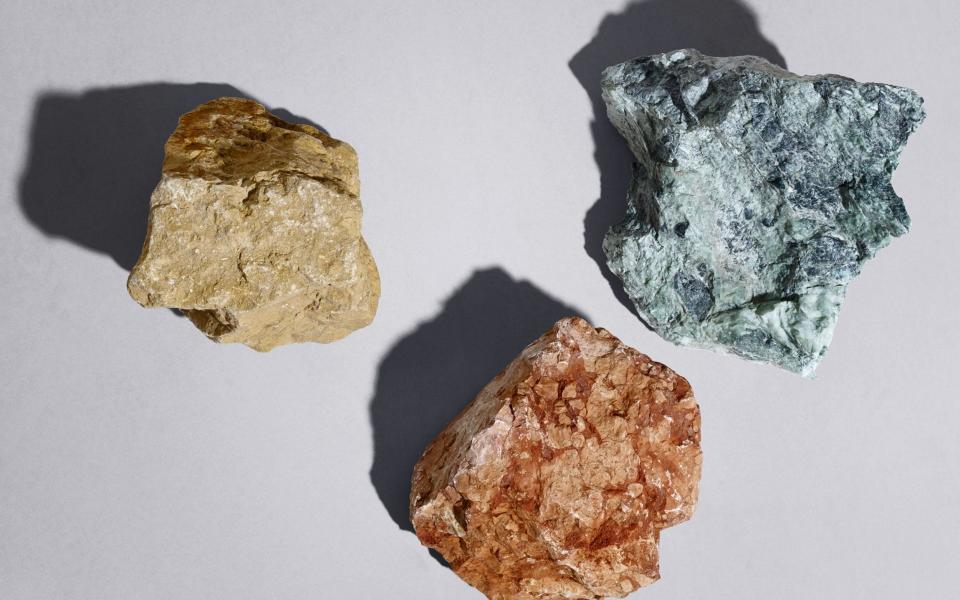
In 21st-century Britain, terrazzo – or a version of it – is also ubiquitous, if not always so sublime. After many decades of being judged utilitarian and bland (see the print on Tube-carriage floors), it has been steadily reappearing as kitchen worktops, bathrooms and everything in between. And far from being a ‘poor man’s marble’, it is fashion-forward, de rigueur in many a modish address. When Soho House Manchester opens later this year, it will feature a rooftop pool with an emerald terrazzo-style patio that looks like borderline crazy paving; almost as jazzy is the version at 180 Corner, the restaurant at 180 The Strand. Then there’s the suitably creamy polished Palladiana at Soho joint Milk Beach… the list goes on.
And it goes beyond mere flooring. One click on Instagram reveals terrazzo-printed curtains, cushions and wallpapers. And lamps, coasters and stationery. John Lewis stocks a terrazzo-look bathroom range featuring flecked tumblers, soap dishes and toilet brushes. Those canny Venetians would be scratching their heads in disbelief.
The revival was kicked off in 2014 when British designer Max Lamb created a fully furnished room in a new terrazzo called Marmoreal. Manufactured by London firm Dzek, it features bright pieces of Italian marble embedded in resin instead of cement, and can be bought by the tile or slab. ‘Lamb’s Marmoreal was my entry point into the beauty of terrazzo and its deep ties to Italian craft and artisanship,’ recalls Trench.
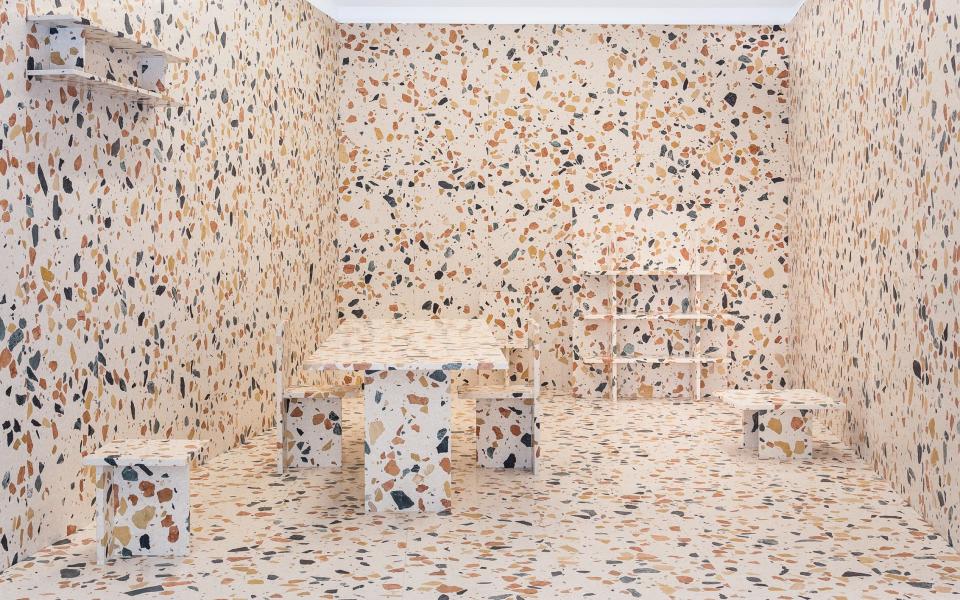
Since then, terrazzo’s usage has been turbocharged. ‘“Terrazzo” has become a buzzword in online searches,’ laments Kate Watson-Smyth, interiors writer and founder of the blog Mad About the House. ‘I remember similar overkill with shiny copper and millennial pink, and we were all thinking, “Please God, make it stop!”’ (The millennial-pink-all-over Gallery at Sketch was, on and off between 2014 and 2019, the most Instagrammed restaurant in London. In 2022, it was redecorated in yellow.)
‘I’m a big fan of terrazzo when it’s used on floors, and in authentic ways,’ she adds, noting Bologna’s colonnades are a favourite with her too, ‘but Formica terrazzo worktops? No! Terrazzo-printed fabrics and plastic terrazzo door handles? They are just wrong. If you abuse a trend in this way, you’re hastening its demise.’
Trench agrees: ‘When you travel around Italy and Greece and see terrazzo in an authentic, everyday context, it’s like seeing an animal in its natural habitat. It’s used with a lightness of touch. In the UK it can be overused, overthought and affected.’
Watson-Smyth adds, ‘There are always issues about when and how to use a material, and in the UK, terrazzo is used too much and often in the wrong way. We all hate pastiche; either have real terrazzo or don’t have it at all.’
But for many designers, it’s a normcore material that keeps on giving. ‘Most of my clients want homes that will look good in 100 years’ time,’ says London-based interior designer Suzy Hoodless. ‘And with terrazzo, you know what you’re going to get. It’s durable, super-reliable and looks like it’s been there forever. I suppose those ridiculous products kill the trend, but it’s a fabrication process that has been around for centuries and you only have to go back to the source to see how great it is.’ And if you’re afraid it will date, then avoid obviously ‘trendy’ varieties and opt for something more classic. Terrazzo will grow old gracefully, like brass, or a Chanel jacket.
If that sounds staid, a young generation of British terrazzeri are adding other materials to the mix. The UK’s marble stash is woefully lacking and somewhat dull. Instead, think wood chip, slate and builders’ rubble. And before our Mediterranean cousins scoff, these versions are sustainable, modern and elegant in their own right.
Stone company Diespeker & Co has been making terrazzo and mosaic for more than a century, and this spring it is launching Rubblazzo. Made using rubble from demolished buildings in London, it features a low-carbon polymer-cement binder and is a collaboration with the garden designer Tom Massey. Rubblazzo is devised with tiles, countertops and moulded pieces in mind and Massey has piloted it on planters in a mobile orchard in London.
Birmingham-based Foresso (whose name is a combination of ‘forest’ and ‘terrazzo’) produces timber terrazzo made with FSC-certified wood offcuts salvaged from local sawmills and building sites. Founder Conor Taylor mixes oak, cedar or walnut that would otherwise be pulped or burned with a bio-based resin to create panels, countertops and furniture. In addition to Foresso’s colourful, busy terrazzos, a No-Chip range is plainer and quieter, made with the company’s own extraction dust.
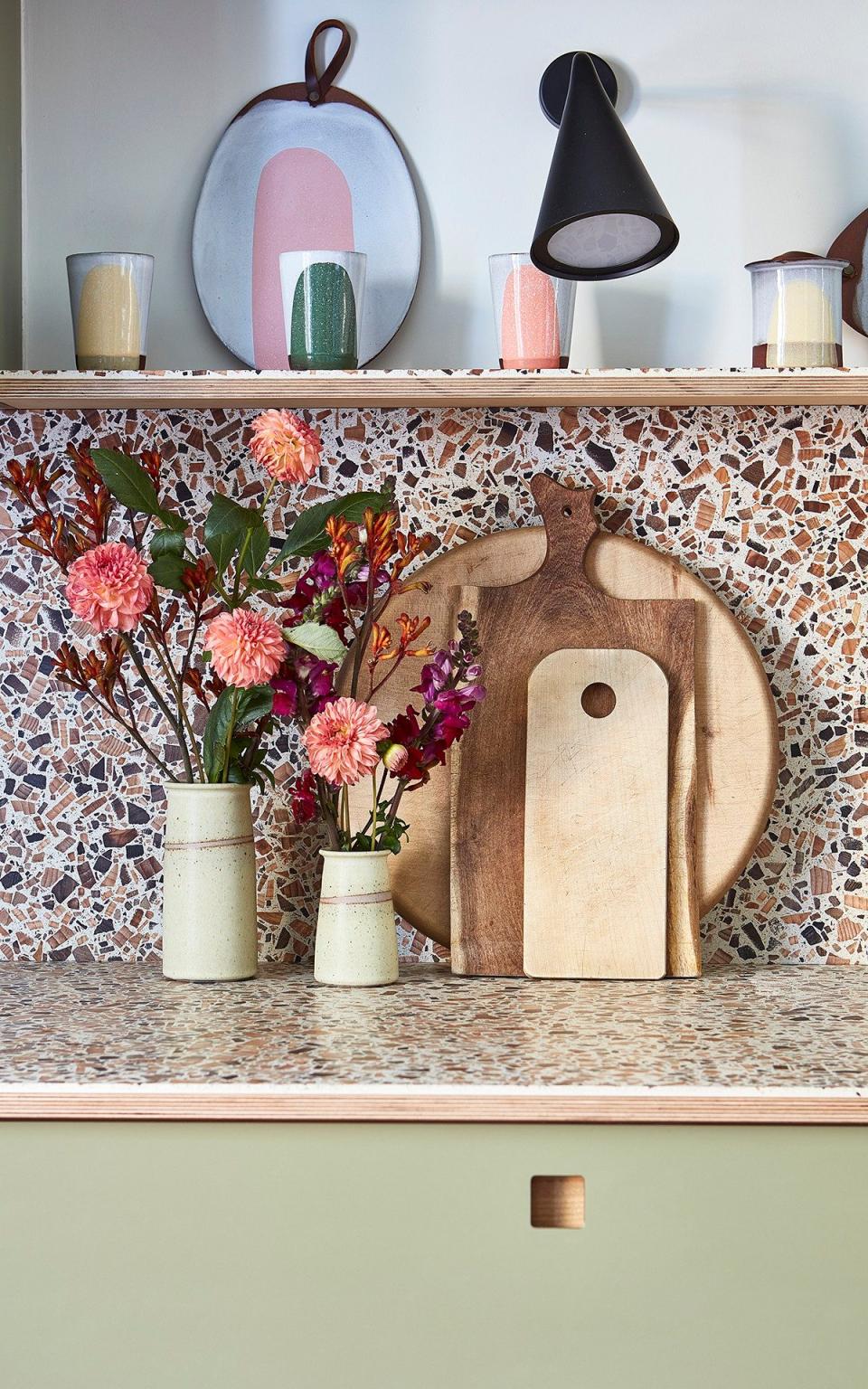
In Liverpool, Granby Rock was born of a refurbishment project on derelict houses in Granby in 2015. Assemble architects and designer and artist Will Shannon set up a mobile workshop at the back of a soon-to-be-refurbished house and transformed broken bricks, slates and other waste into decorative mantelpieces. Assemble won the Turner Prize for its work on the regeneration, and set up the social enterprise Granby Workshop, which has clients all over the world and pieces in the V&A’s permanent collection. It aims to include as many industrial waste products as possible; a new addition is ground granulated blast-furnace slag from iron-making. It may not sound promising, but it looks good.
‘Companies like Granby Workshop are making Herculean efforts and we should embrace those efforts,’ says Fiona Ginnett, creative director of Hackney-based Hølte, which makes hand-finished fronts and worktops for Ikea cabinet carcasses with an emphasis on eco-friendly materials. ‘When it comes to carbon footprint and waste, worktops are some of the worst offenders,’ she explains, ‘but terrazzo can be a fantastic choice for kitchen worktops and flooring. It’s hard-wearing and easy to clean, and UK-made versions reduce transport emissions and are a more sustainable choice.’
These new options have shaken up what was, in Britain at least, ‘an old-school industry with a predictable aesthetic’, says London-based designer Robin Grasby. In 2018, he launched Altrock, whose big marble chips float, asteroid-like, in a fleck-free resin. This year, Altrock debuts a ready-made collection of terrazzo in seven colours which ranges from subtle tone-on-tone shades to bold contrasting colours.
Flat, matt surfaces rather than Fabergé-egg shine are voguish right now, but any finish can be achieved with the right amount of polish, and terrazzo also works well at many different scales. ‘Small pieces are more classic and the large-scale designs look really modern and contemporary,’ says Hoodless, who regularly uses it for bathrooms and basins. ‘It has an aesthetic that can constantly evolve,’ adds Grasby, who plans to stay one step ahead of any trends.
In the right hands, terrazzo can be an artwork in itself. At Mount St restaurant in London, American artist Rashid Johnson’s Broken Floor is a kaleidoscope of irregularly shaped, seemingly random pieces embedded in a mix. It is laid out in straight lines and jagged edges. ‘We had at least a dozen samples of all possible sizes on which several grout tests were performed,’ explains architect Luis Laplace. ‘We lost count of how many meetings we had to achieve the result we see today, which enables diners to see the work from wherever they are seated.’
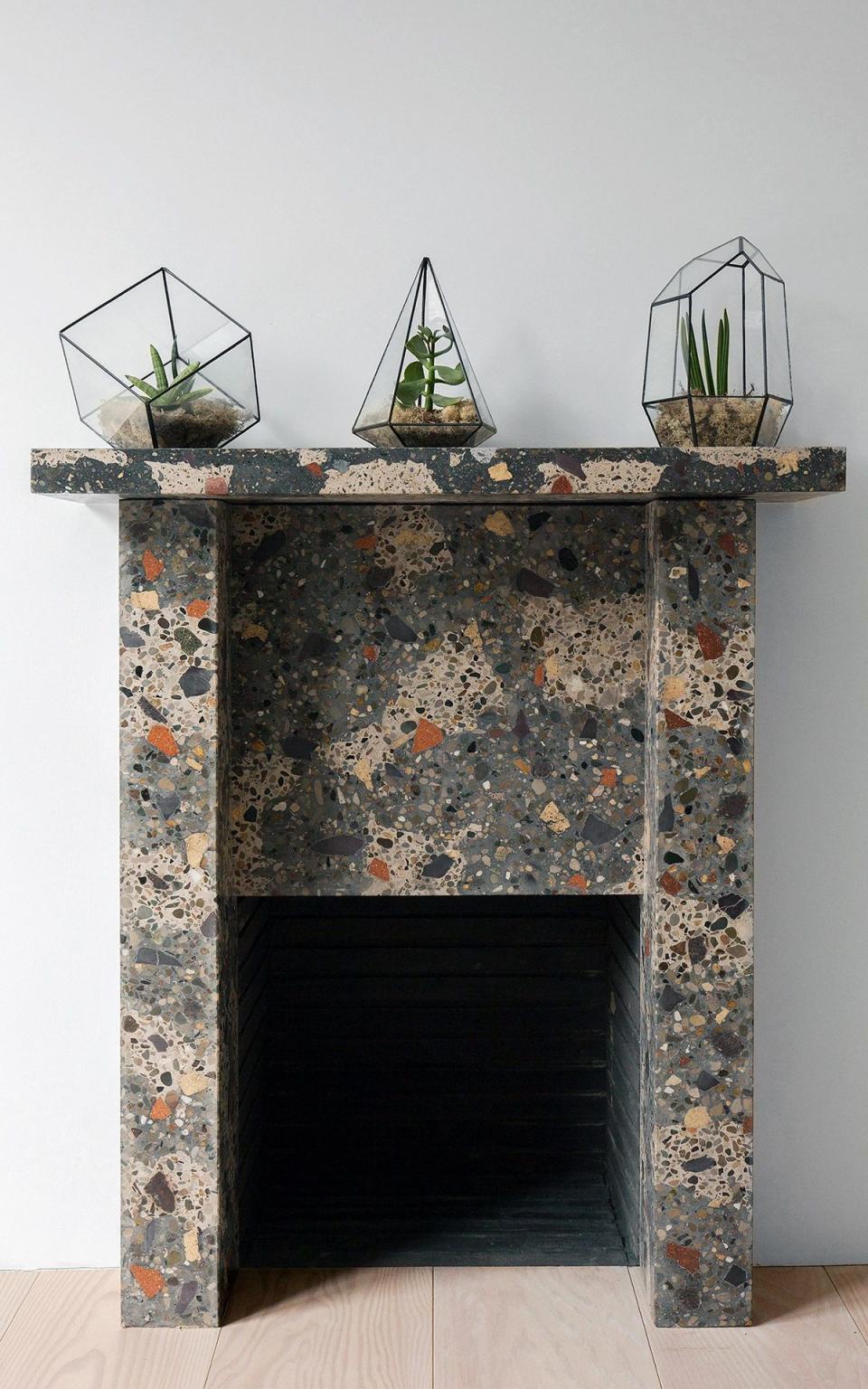
Johnson’s may be the ne plus ultra, but laying a standard version can be straightforward. Especially in Italy, where those with the skills to do so are in abundance. As the owner of a 1960s house on a lake in Piedmont, as it happens not far from the Candoglia quarry, terrazzo was the obvious choice for my bathroom and kitchen walls, floors and work surfaces. Hampered by lockdowns and the threat of flooding, we kept it simple: local green and black stone provided the colour, and local firm Cantoia Roberta the skills. Covid forbade us from witnessing the work, but Signor Roberta recounted the process like a chef explaining his favourite cake recipe.
‘We mixed Verde Alpi marble in 8 x 12mm pieces in a concrete mixer with grey cement and green oxide. We spread the mix with a thickness of 2.5cm on top of a pre-prepared sub floor and inserted brass interruption joints to accommodate structural shifts, which can lead the floor to crack.’ (Which it did.) ‘Then we compacted it with a metal roller to squeeze out excess cement. After 10 days of drying we sanded and polished it to a smooth finish.’
All the mixing, pouring and smoothing really is like making a cake, and like cake, terrazzo is now embedded in the British psyche. As demand for truly long-lasting home products grows, it holds too much potential to simply be a passing Instagram trend. My own floor is strong, elegant and looks like it’s been there forever; so stunning that washing it (almost) doesn’t feel like a chore.

